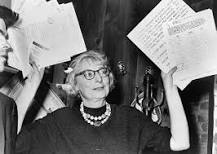In this blog, we are attempting to answer some of our questions: Why are there not more walkable neighborhoods in Worcester? How can we develop more open, spontaneous public spaces in our city? There is plenty to do here but why does it seem like there is nothing to do? Why do we travel to Boston, Providence, even Northampton for the kind of urban vitality that we crave? Why does this city feel so, so, so…. suburban!? A way to unpack these answers is to compare two competing urban planning models fighting it out since the 1950s and 1960s. To understand how this urban planning war manifested in cities across the country, let’s go to New York City where in the 1960s, Robert Moses and Jane Jacobs wrestled aggressively over the vision of what “Gotham” should be post WWII in the age of automobiles and new suburbs.
Known as “the master builder”, Robert Moses never held political office but he wielded more power than most politicians. In a career spanning from 1924 to 1968, he held over twelve key administrative appointments (examples include head of the NYC Department of Parks and head of the NYC Planning Commission) that allowed him full reign free from any public oversight to create New York City in the way he dreamed it should be. He never drove a car himself but he intended to make New York a place fully accessible for suburbanites who were driving in and out of the city. Forget public transportation. He was going to build roads and major highways circulating in and out of the city. He didn’t care if there were living neighborhoods in the way. He was going to slice those roads right through it. When he looked at urban neighborhoods with haphazard houses next to stores next to factories, all he saw were slums. He craved the order of big projects that would take up a whole urban block or even blocks. The city should be clean, orderly and made uncrowded. Thin out that dense network of people. Spread out. Robert Moses singlehandedly changed the design architecture of New York, building bridges, highways and parkways, tunnels as well as a whole network of public parks, playgrounds and public housing projects. He was a huge fan of housing towers surrounded by empty green space. Think Plumley Village, Worcesterites. In his top-down approach to urban development, he knew what was best and he could get things done. Forget about the people who live in actual neighborhoods to decide their development future. In his world view, they simply did not count. During this era, cities across the country hired Moses as a consultant to offer advice on how to emulate his New York model and to build highways circulating and crossing through the city.
“Cities are created by and for traffic….When you operate in an overbuilt environment, you have to hack your way with a meat ax.”
A Comparison Chart of the Two Major Urban Planning Paradigms
Robert Moses was used to getting his way, pushing highways through neighborhoods and displacing homes and businesses in the name of “urban renewal.” Who would have thought that a woman originally from Scranton, Pennsylvania would foil his plans to build a highway through Lower Manhattan, an access road through Washington Square Park and to raze huge portions of Greenwich Village that he saw as “blight.” In 1961, when Jane Jacobs picked up a newspaper to read the news that her Greenwich Village neighborhood had been targeted for “urban renewal,” she probably never expected that she would begin a long and ultimately successful fight against Robert Moses’ plans for her community. She had already gained a bit of notoriety with her 1958 article, Downtown is for the People, in Fortune Magazine and in 1961, published her main urban planning ideas in the classic, Death and Life of Great American Cities. Where Moses saw “slum”, Jane Jacobs saw urban life and vitality. She observed how crooked streets, short city blocks, many people living closely together (high density), an interesting mix of residential, retail, industrial and cultural uses together could all build a thriving city neighborhood. It’s a misconception to think that she was against public spending on large infrastructure projects. She just didn’t think funds should be spent to benefit private automobile use. She asserted that the best way to build a city was to invest heavily in public transportation and advocated for a renewed public financial commitment to re-building New York City’s subway and rail systems. She also staunchly disagreed with the cataclysmic approach to development that cut down entire neighborhoods in one sweep. Any successful urban neighborhood would develop gradually, one small project at a time and would include new usages of old buildings as well as the building of new buildings.
“We are greatly misled by talk about bringing the suburb into the city. The city has its own peculiar virtues and we will do it no service by trying to beat it into some inadequate imitation of the non city.”
A potential indicator of a Robert Moses type urban renewal project is when whole city blocks are razed at one time. Look for where the bulldozers are most active! This photo was taken at the current construction City Square site. Instead of a gradual approach to development and the infusion of what Jacobs calls "gradual money", these projects have a startling, cataclysmic impact on a city.
Following the bulldozers, we find the same Robert Moses development model happening in the canal district. Currently, this whole block is being razed for the building of the upcoming hockey rink.
Cities all across the country decided the fate of their future by fighting over and then choosing one of these two development models. So, here is the important question: In the past fifty years, what has won out in Worcester? The urban planning paradigm of Robert Moses or of Jane Jacobs? What’s your thought?




